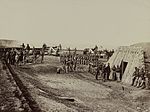Queens Chapel
Neighborhoods in Northeast (Washington, D.C.)Washington, D.C., geography stubs

Queens Chapel is a mostly residential neighborhood with commercial elements located in Ward 5 of Northeast Washington, D.C.Its namesake is the Queens Family Chapel, the first Catholic parish in DC. It burned to the ground multiple times, the last fire occurring during the Battle of Bladensburg. It was later rebuilt as St Francis de Sales Church in 1906.
Excerpt from the Wikipedia article Queens Chapel (License: CC BY-SA 3.0, Authors, Images).Queens Chapel
Ingraham Street Northeast, Washington
Geographical coordinates (GPS) Address Nearby Places Show on map
Geographical coordinates (GPS)
| Latitude | Longitude |
|---|---|
| N 38.9546 ° | E -76.9974 ° |
Address
Ingraham Street Northeast 541
20011 Washington
District of Columbia, United States
Open on Google Maps







